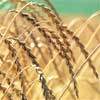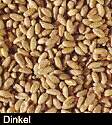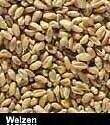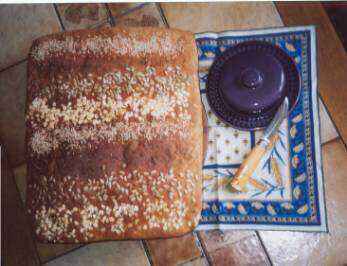 |
[ZAWiW] [gemeinsamlernen] [LiLL] | ||
|
|
||
| home | ||
|
|
Doris Becker | |
|
|
Ruth Dassler | |
|
|
Jutta Gotthart | |
|
|
Anneliese Haas | |
|
|
Erich Regula | |
|
|
Hildegard Keller | |
|
|
Lilo Nold | |
|
|
M.&H. Schwiebert | |
|
|
Brigitte Trojahn | |
|
|
Agathe Wende | |
 |
||
Erich Regula
Stand:Spelt Bread
 Erich Regula
Erich Regula
History

 Spelt wheat (Triticum spelta, German wheat, "Dinkel", Swabian corn) is a primitive species of cereals. Developed probably by crossing of primitive husk wheat varieties in south west Asia, spelt was common since the Neolithic age from Sweden to the Southern Alps. Later on it was cultivated particularly in the Roman provinces north of the Alps and taken over there by the Alemans. Up to the 19th century spelt was the main grain in the Alemannic settlement area: Swabia including Bavarian Swabia, southern plain of Rhine, Vorarlberg and German Switzerland.
Spelt wheat (Triticum spelta, German wheat, "Dinkel", Swabian corn) is a primitive species of cereals. Developed probably by crossing of primitive husk wheat varieties in south west Asia, spelt was common since the Neolithic age from Sweden to the Southern Alps. Later on it was cultivated particularly in the Roman provinces north of the Alps and taken over there by the Alemans. Up to the 19th century spelt was the main grain in the Alemannic settlement area: Swabia including Bavarian Swabia, southern plain of Rhine, Vorarlberg and German Switzerland.

 Starting from end of the 19th century spelt was displaced ever more by wheat, which supplies higher yield and is more easily to be processed in the mill. In the middle of the 20th century the cultivation of spelt had almost disappeared. Only for the production of "Grünkern"- green spelt, harvested before ripening and used as soup insert - there was still contract cultivation for the soup industry. Only with the health wave of the 70's and 80's spelt was discovered again. Today many mills process spelt again and it is available as grain and as flour not only in health food shops, but even in supermarkets.
Starting from end of the 19th century spelt was displaced ever more by wheat, which supplies higher yield and is more easily to be processed in the mill. In the middle of the 20th century the cultivation of spelt had almost disappeared. Only for the production of "Grünkern"- green spelt, harvested before ripening and used as soup insert - there was still contract cultivation for the soup industry. Only with the health wave of the 70's and 80's spelt was discovered again. Today many mills process spelt again and it is available as grain and as flour not only in health food shops, but even in supermarkets.
Characteristics
In cultivation spelt is more modest than wheat, thriving also on bad soils and in rough climate. In contrast to wheat, where the grains are separated easily from the husks by threshing, the husks are firmly connected with the grain. They must be separated in a special process called "gerben". The close connection with the tough husks protects the grain against diseases and against the penetration of pollutants, therefore the use of pesticides is hardly necessary.
The good characteristics of spelt were estimated since old times. An old farmer wisdom means: Give a mixture of spelt and wheat grains to chicken, and you will see, how each spelt grain is picked before the wheat.
Some 800 years ago Hildegard von Bingen, (St.Hildegard) wrote about spelt:
"The spelt is the best of grains. It is rich and nourishing and milder than other grain. It produces a strong body and healthy blood to those who eat it and it makes the spirit of man light and cheerful. If someone is ill boil some spelt, mix it with egg and this will heal him like a fine ointment."
The table shows the nutrient composition of wheat and spelt [4]
|
|
wheat |
spelt |
|
energy |
313 kcal 1310 kJ |
312 kcal 1322 kJ |
|
water |
13,0 % |
12,0 % |
|
protein |
11,7 % |
13,0 % |
|
fat |
2,0 % |
3,1 % |
|
carbonhydrates |
61,0 % |
58 % |
|
dietary fibre |
10,3 % |
12,0 % |
|
minerals |
1,8 % |
1,8 % |
Thus spelt has higher protein and fat content than wheat. Also the proportion of essential amino acids is higher in spelt.[5 ].
 According to own experiences the dough characteristics of wholemeal spelt flour are better than with wholemeal wheat. Spelt bread is less liable to crumbling and drying out. It remains juicier and shows more aromatic taste.
According to own experiences the dough characteristics of wholemeal spelt flour are better than with wholemeal wheat. Spelt bread is less liable to crumbling and drying out. It remains juicier and shows more aromatic taste.
Green spelt (Grünkern): Beside the ripe grains spelt is harvested also in immature state. This was originally a makeshift solution. Unfavourable weather or danger of war forced the farmers to harvest spelt before ripening and to dry it in the oven. Because of its particularly hearty taste green spelt is specially estimated for soups and other meals.
My personal relationship with this bread
When I retired I took over domestic bread baking from my wife. First I used principally wholemeal wheat grits, but this bread was liable to crumbling. Therefore I tried it once with wholemeal spelt flour, and the resulting bread was not only stable in cutting and of good porosity, it was also juicier and more aromatic. Since that time spelt flour is used for every bread in our household. Furthermore it is a good feeling to use a cereal with such rich history and reputation.
Recipes
Spelt Bread
0.5 kg wheat flour
2 teaspoons salt
1 ½ cubes baking yeast
ca. 100 ml milk
1 teaspoon sugar
about 1 l warm water
1 handful peeled sunflower seeds
Preparation: Das Mix flour, salt and sunflower seeds in a kneading bowl. Dissolve sugar in warmed milk, add crumbled yeast and stir. Make a deepening in the flour mixture, put in the yeast solution and cover with some flour, leave 15 minutes for fermentation. Add an amount of warm water to give a dough which can be well kneaded. Knead vigorously until the dough is detaching from the bowl. Leave to rest ½ to ¾ hour. Spread flour on the table, knead the piece of dough with hands covered with flour. Mould six loafs, put on a greased baking tin. Leave resting further ½ hour. Bake in oven (gas: step 4-5) about 45 minutes. One loaf is just right for two people, the rest is kept in the freezer.
 This basic formula can be varied in different mode: Spelt and wheat flour can be mixed in all proportions, pure wholemeal spelt bread is very good too. Wheat and rye grits, rolled oats, oilseeds or spices can be added. When you use rye flour, some acidifying agent should be added: sourdough, sour milk products or the like. Our guests like our "party flat bread": Prepare dough from ½ kg wholemeal spelt flour and ½ kg wheat flour, spread on a baking tin, cover stripes with rolled oats, caraway, poppy, sesame, sunflower or pumpkin seeds (see picture).
This basic formula can be varied in different mode: Spelt and wheat flour can be mixed in all proportions, pure wholemeal spelt bread is very good too. Wheat and rye grits, rolled oats, oilseeds or spices can be added. When you use rye flour, some acidifying agent should be added: sourdough, sour milk products or the like. Our guests like our "party flat bread": Prepare dough from ½ kg wholemeal spelt flour and ½ kg wheat flour, spread on a baking tin, cover stripes with rolled oats, caraway, poppy, sesame, sunflower or pumpkin seeds (see picture).
Numerous recipes with spelt and green spelt can be found in the book "Dinkel" [1]: Muesli, bread spreads, salads, soups, main dishes, desserts, different baked goods.
Literature and Links:
[1] G. Schnabel, S. Ruoß: Dinkel. Ruoß-Verlag, Ulm 1997[2] C. Stüwe: „Ein Getreide, wie für die Alb geschaffen“. Südwest-Presse, 18.8.01
[3] http://www.hildegard.de/dinkel.htm
[4] Bundes-Lebensmittelschlüssel BLS II.2 1994
[5] http://www.inform24.de/getreide.html
[6] http://www.brot.ch/brotmehl/saenundernten/getreidearten.htm
[7] http://www.dradio.de/dlr/sendungen/mahlzeit/archiv.html
